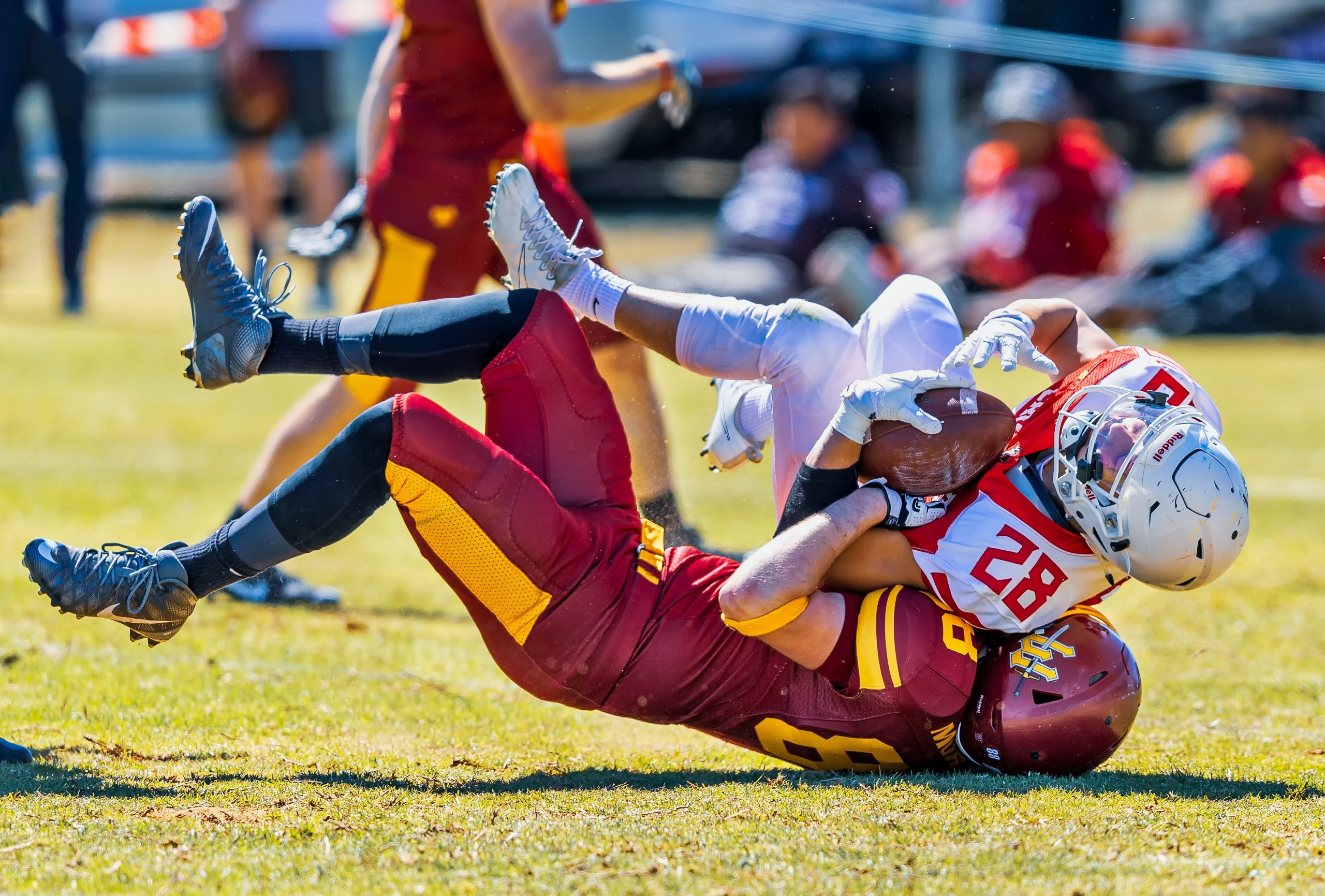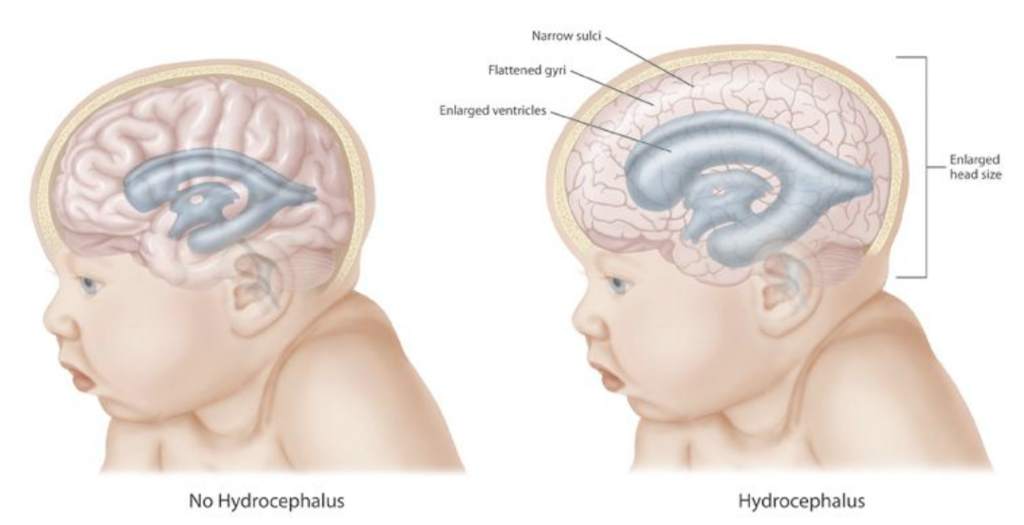7.1 Case Study: Under Pressure
Created by CK-12/Adapted by Christine Miller

Looking at this photo of a football game (Figure 7.1.1), you can see why it is so important that the players wear helmets. As players tackle each other, football often involves forceful impact to the head. This can cause damage to the brain — temporarily (as in the case of a concussion) or long-term and more severe. Helmets are critical in reducing the incidence of traumatic brain injuries (TBIs), but they do not fully prevent them.
As a former professional football player who also played in college and high school, 43-year-old Jayson sustained many high-impact head injuries over the course of his football playing years. A few years ago, Jayson began experiencing a variety of troubling symptoms, including the loss of bladder control (the involuntary leakage of urine), memory loss, and difficulty walking. Symptoms like these are often signs of damage to the nervous system, which includes the brain, spinal cord, and nerves, but they can result from many different types of injuries or diseases that affect the nervous system. In order to treat him properly, Jayson’s doctors needed to do several tests to determine the exact cause of his symptoms. The doctors ordered a spinal tap to see if he had an infection, and an MRI (magnetic resonance imaging) to see if there were any observable problems in and around his brain.
The MRI revealed the cause of Jayson’s symptoms. There are fluid-filled spaces within the brain called ventricles, and compared to normal ventricles, Jayson’s ventricles were enlarged. Based on this observation, along with the results of other tests, Jayson’s doctor diagnosed him with hydrocephalus, a term that literally means “water head.” Hydrocephalus occurs when the fluid that fills the ventricles — called cerebrospinal fluid — builds up excessively, causing the ventricles to become enlarged. This puts pressure on the brain, which can cause a variety of neurological symptoms, including the ones Jayson was experiencing. In Figure 7.1.2, you can see the difference between normal ventricles and ventricles that are enlarged due to hydrocephalus. Notice in the image on the right how the brain becomes “squeezed” due to hydrocephalus.

Hydrocephalus often occurs at birth, as a result of genetic factors or events that occurred during fetal development. Because babies are born with skull bones that are not fully fused, the skull of a baby born with hydrocephalus can expand and relieve some of the pressure on the brain, as reflected in the enlarged head size shown in Figure 7.1.2. Adults have fully fused, inflexible skulls, so when hydrocephalus occurs in an adult, the brain experiences all of the increased pressure.
Why did Jayson develop hydrocephalus? There are many possible causes of hydrocephalus in adults, including tumors, infections, hemorrhages, and TBIs. Given his repeated and long history of football-related TBIs and the absence of any evidence of infection, tumor, or other cause, Jayson’s doctor thinks his head injuries were most likely responsible for his hydrocephalus.
Although hydrocephalus is serious, there are treatments. Read the rest of this chapter to learn about the cells, tissues, organs, cavities, and systems of the body, how they are interconnected, and the importance of keeping the body in a state of homeostasis (or balance). The amount of cerebrospinal fluid in the ventricles is normally kept at a relatively steady level, and the potentially devastating symptoms of hydrocephalus are an example of what can happen when a system in the body becomes unbalanced. At the end of the chapter, you will learn about Jayson’s treatment and prognosis.
Chapter Overview: Introduction to the Human Body
In this chapter, you will learn about the general organization and functions of the human body. Specifically, you will learn about:
- The organization of the body from atoms and molecules up through cells, tissues, organs, and organ systems.
- How organ systems work together to carry out the functions of life.
- The variety of different specialized cell types in humans, the four major types of human tissues, and some of their functions.
- The five vital organs and the 11 major organ systems of the human body.
- Spaces in the body called body cavities, and the organs they hold and protect.
- The tissues and fluid that protect the brain and spinal cord.
- How organ systems communicate and interact in body processes, such as cellular respiration, digestion, the fight-or-flight response to stressors, and physical activities (such as sports).
- How homeostasis is maintained to keep the body in a relatively steady state, and the problems that can be caused by loss of homeostasis, such as diabetes.
As you read the chapter, think about the following questions:
- What is the normal function of cerebrospinal fluid?
- What is a spinal tap and how does it test for infection?
- In Jayson’s case, what organs and organ systems are probably affected by his hydrocephalus? What are some ways in which these organ systems interact?
- The level of cerebrospinal fluid is normally kept in a state of homeostasis. What are other examples of types of homeostasis that keep your body functioning properly?
Attributions
Figure 7.1.1.
Football tackel [photo] by John Torcasio on Unsplash is used under the Unsplash License (https://unsplash.com/license).
Figure 7.1.2
Hydrocephalus by Centers for Disease Control and Prevention (CDC) on Wikimedia Commons is in the public domain (https://en.wikipedia.org/wiki/Public_domain).
References
Mayo Clinic Staff. (n.d.). Hydrocephalus [online article]. MayoClinic.org. https://www.mayoclinic.org/diseases-conditions/hydrocephalus/symptoms-causes/syc-20373604
Mayo Clinic Staff. (n.d.). Traumatic brain injury [online article]. MayoClinic.org. https://www.mayoclinic.org/diseases-conditions/traumatic-brain-injury/symptoms-causes/syc-20378557
Sudden damage to the brain caused by a blow or jolt to the head. Common causes include car or motorcycle crashes, falls, sports injuries, and assaults. Injuries can range from mild concussions to severe permanent brain damage.
A condition where there is an abnormal build up of CSF (cerebrospinal fluid) in the cavities (ventricles) of the brain, also called water in the brain. The build-up is often caused by an obstruction that prevents proper fluid drainage.
The ability of an organism to maintain constant internal conditions despite external changes.
The smallest particle of an element that still has the properties of that element.
A molecule is an electrically neutral group of two or more atoms held together by chemical bonds.
The smallest unit of life, consisting of at least a membrane, cytoplasm, and genetic material.

